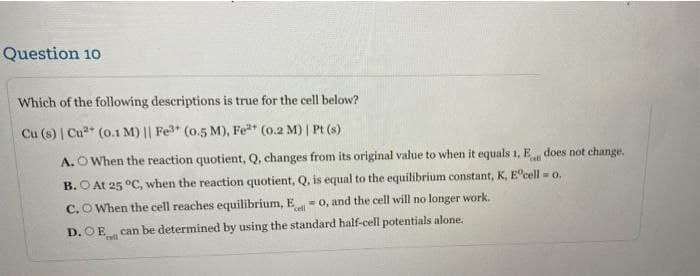Question 10 Which of the following descriptions is true for the cell below? Cu (s) | Cu (0.1 M) || Fe (o.5 M), Fe (0.2 M) | Pt (s) A. O When the reaction quotient, Q, changes from its original value to when it equals 1, E does not change. B. O At 25 °C, when the reaction quotient, Q, is equal to the equilibrium constant, K, E°cell - o. C.O When the cell reaches equilibrium, E- o, and the cell will no longer work. "cell D. OE can be determined by using the standard half-cell potentials alone.
Question 10 Which of the following descriptions is true for the cell below? Cu (s) | Cu (0.1 M) || Fe (o.5 M), Fe (0.2 M) | Pt (s) A. O When the reaction quotient, Q, changes from its original value to when it equals 1, E does not change. B. O At 25 °C, when the reaction quotient, Q, is equal to the equilibrium constant, K, E°cell - o. C.O When the cell reaches equilibrium, E- o, and the cell will no longer work. "cell D. OE can be determined by using the standard half-cell potentials alone.
Chemistry: The Molecular Science
5th Edition
ISBN:9781285199047
Author:John W. Moore, Conrad L. Stanitski
Publisher:John W. Moore, Conrad L. Stanitski
Chapter17: Electrochemistry And Its Applications
Section: Chapter Questions
Problem 110QRT
Related questions
Question

Transcribed Image Text:Question 10
Which of the following descriptions is true for the cell below?
Cu (s) | Cu* (0.1 M) || Fe3 (0.5 M), Fe (0.2 M) | Pt (s)
A. O When the reaction quotient, Q, changes from its original value to when it equals 1, E does not change.
cell
B. O At 25 °C, when the reaction quotient, Q, is equal to the equilibrium constant, K, E°cell = 0.
C.O When the cell reaches equilibrium, E
cell
=0, and the cell will no longer work.
D. OE can be determined by using the standard half-cell potentials alone.
eall
Expert Solution
This question has been solved!
Explore an expertly crafted, step-by-step solution for a thorough understanding of key concepts.
This is a popular solution!
Trending now
This is a popular solution!
Step by step
Solved in 2 steps

Knowledge Booster
Learn more about
Need a deep-dive on the concept behind this application? Look no further. Learn more about this topic, chemistry and related others by exploring similar questions and additional content below.Recommended textbooks for you

Chemistry: The Molecular Science
Chemistry
ISBN:
9781285199047
Author:
John W. Moore, Conrad L. Stanitski
Publisher:
Cengage Learning


Chemistry
Chemistry
ISBN:
9781305957404
Author:
Steven S. Zumdahl, Susan A. Zumdahl, Donald J. DeCoste
Publisher:
Cengage Learning

Chemistry: The Molecular Science
Chemistry
ISBN:
9781285199047
Author:
John W. Moore, Conrad L. Stanitski
Publisher:
Cengage Learning


Chemistry
Chemistry
ISBN:
9781305957404
Author:
Steven S. Zumdahl, Susan A. Zumdahl, Donald J. DeCoste
Publisher:
Cengage Learning

Chemistry: An Atoms First Approach
Chemistry
ISBN:
9781305079243
Author:
Steven S. Zumdahl, Susan A. Zumdahl
Publisher:
Cengage Learning

Chemistry: Principles and Practice
Chemistry
ISBN:
9780534420123
Author:
Daniel L. Reger, Scott R. Goode, David W. Ball, Edward Mercer
Publisher:
Cengage Learning

Principles of Instrumental Analysis
Chemistry
ISBN:
9781305577213
Author:
Douglas A. Skoog, F. James Holler, Stanley R. Crouch
Publisher:
Cengage Learning